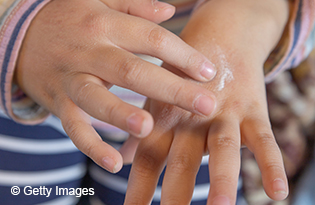Understanding eczema: The 'ecz-asperating' rash
9/16/2024 by Afia Brago Adu-Gyamfi, M.D.

What is eczema?
Eczema, or atopic dermatitis, is a common skin condition affecting at least 1 in 10 children. It causes dry, red and itchy skin and is associated with sensitive skin.
Why does eczema happen?
Eczema occurs because of breaks in the skin barrier. Kids with eczema don't have enough filaggrin protein in their skin. Without enough filaggrin, the skin has a harder time holding in moisture and keeping out irritants. Both genes and the environment play a role so it can run in families. It is tied to other allergic diseases like asthma and seasonal allergies. Some kids will start to outgrow it by age 4.
Some children have eczema flares after eating certain foods, but the actual food does not cause eczema. Focusing on taking care of the skin barrier is more important than eliminating the food.
Where does eczema typically show up? Can others catch it?
Eczema can appear differently and change location based on age. In babies, it typically occurs on the cheeks, face, around the mouth and scalp. In school-aged children, it often happens on the neck, elbow creases and behind the knees.
It is NOT contagious. Although kids with eczema are more prone to skin infections, the condition itself doesn’t spread from person to person.
How to tame the 'ecz-asperating' rash
- Moisturize: Use creams or ointments right after bathing to help hold in moisture. Choose products without fragrances, like plain Vaseline or Vanicream.
- Avoid triggers: Avoid soaps and laundry detergent with fragrance or itchy fabric.
- Use over-the-counter hydrocortisone 1% twice a day: This helps reduce itching and inflammation. Buy one that is unscented and apply it first before lotion. Use it for no more than 14 days at a time and take a 1-week break before resuming it if still needed.
- Don't scratch: Teach your child to tap or gently rub their skin instead.
When to see a healthcare clinician
If the rash still bothers your child after trying these tips, or if their skin becomes very red, swollen, or starts to ooze or has yellowish crusting, call their clinician for an evaluation.
Afia Brago Adu-Gyamfi, M.D., is a third-year Mayo Clinic Pediatric and Adolescent Medicine resident. She graduated from the Medical College of Wisconsin in Milwaukee and is interested in atopic dermatitis, food allergies, immunodeficiencies and asthma.
